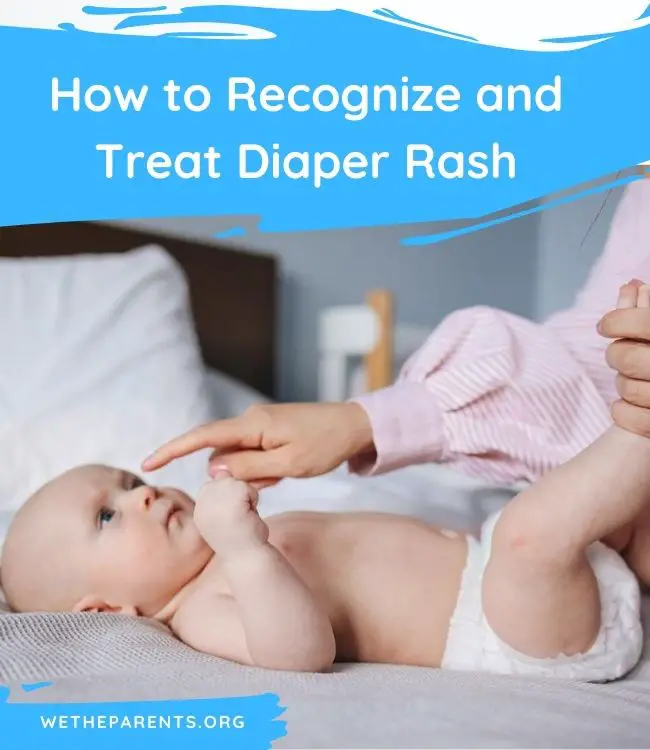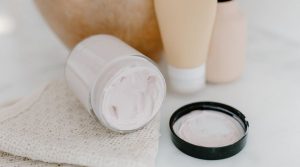Every mom has experienced it — baby seems fussy, fidgety, and ill-tempered, but the reason behind it is a mystery. Then, a routine diaper check reveals the telltale bright red and patchy start of the all-too-common malady, diaper rash.
Learning to treat and prevent this routine skin condition is not difficult, but those who don’t know the ins and outs of diaper rashes may wonder what went wrong, how to prevent future occurrences, and even if diaper rash merits a visit to the pediatrician for medical advice.
We’ll cover all that and more, so read on.
What is diaper rash?
Diaper rash refers to a type of skin inflammation known as dermatitis and is usually found in the area around the buttocks, genitals, and surrounding skin.
It appears as visibly irritated, small or large red patches of skin. Moisture from missed diaper changes, allergic reactions, infections, and chafing are all possible causes of this rash.
Although it can be uncomfortable for babies, with an appearance to match, the condition can usually be resolved at home without the need for a pediatrician.
What are the main symptoms of diaper rash?
As diaper rash is a skin condition rather than a systemic illness, the presentation of symptoms comes down to the appearance of the rash itself and your child’s reaction to it. Basically, there are two ways to detect diaper rash:
- Relatively minor cases may be noticed during a routine diaper change, before the rash is severe enough for baby to react. Diaper rash has a bright red, tender, patchy appearance and may be seen on the diaper area of baby’s skin, including buttocks, genitals, thighs, and surrounding area.
- If baby seems fussy, uncomfortable, and annoyed for no particular reason, or reacts with fussing or tears during diaper changes, look carefully to check if there’s a rash present.
Can diaper rash be serious?
Typically, diaper rash is not a serious condition and should resolve through home treatment within a few days. However, if the baby’s rash doesn’t improve, you may need to visit your doctor for some prescription cream.
Other situations in which diaper rash merits a trip to the doctor:
- The diaper rash looks unusually severe, unlike standard diaper rash
- The diaper rash is not improving in response to your treatment attempts
- The diaper rash is bleeding, oozing, or itching
- Baby is unable to urinate or defecate without pain due to the diaper rash
- They have a fever
Editor’s Note:
In clinical practice, I commonly see infants with diaper rashes that are not improving. Often, more than one over-the-counter diaper rash cream has been tried, but the rash persists. Such rashes may be caused by fungal overgrowth or, less commonly, by bacteria, and require prescription treatment.1Blume‐Peytavi, U., & Kanti, V. (2018). Prevention and treatment of diaper dermatitis.Pediatric dermatology, 35, s19-s23.
onlinelibrary.wiley.com
How do I treat diaper rash?
Proper treatment of diaper rash usually rectifies the uncomfortable condition within a few days. Here are some recommended practices to follow when treating your little one’s rash:2Diaper Rash
kidshealth.org/en/parents/diaper-rash.html?ref=search
- Approved creams only: Use creams designed for diaper rash, such as those that are zinc oxide or petroleum jelly-based, unless your pediatrician prescribes otherwise. Using strong steroidal creams or steroids can be bad for your child in the long term. If your doctor does prescribe a cream that contains a steroid, it is typically intended for only one or two weeks of use. Diaper rashes caused by infections should be treated with an appropriate antifungal cream or antibiotic.
- Change diapers frequently: Keep baby’s diaper area dry and clean as often as possible. This means changing baby as soon as you’re aware of a soiled diaper, while thoroughly cleaning and drying baby’s bum during the change. Some parents prefer to give baby a full “wash” with each diaper change by keeping a water spray bottle near the changing station. Finish the diaper change with a thorough pat-dry, and create a moisture barrier using an approved petroleum jelly or zinc oxide based cream. For infants who get frequent diaper rashes, I recommend using a small hand-held fan to make sure the area is very dry before putting on a clean diaper.
- Let their skin breathe: Don’t be afraid to let baby go without a diaper for a while. Air-drying is one of the best things for baby’s skin, so lay them on an old towel and let their skin breathe whenever possible.
- A daily bath: Daily baths in warm water with mild, fragrance-free soap helps to whisk bacteria and yeast away from baby’s sensitive skin, helping to relieve the rash and prevent its spread. Make sure baby is fully dry and that cream is used before they go back into a diaper.
What are the best ways to prevent diaper rash?
Adopting some good habits in your baby’s care will go a long way to prevent future outbreaks of diaper rash. Once you master these simple rules, they’ll become second nature — and the baby’s sensitive skin will thank you!
- Keep skin clean, dry as often as possible: Clean, dry skin is best for avoiding rashes and irritation, which means that parents must change wet or soiled diapers as soon as possible. Yes, we know, this can become costly when using disposable diapers for a frequent producer or sick child. Parents who find themselves going through too many packs may consider switching to cloth diapers, some of which have adjustable sizes to prevent chafing as baby grows.
- A full clean during their change: Whether you dunk baby in the tub or just use a handy spray bottle of room temperature or warm water, giving baby’s bottom a full clean while they’re being changed means less bacteria lingering on their skin to cause irritation and infection. If you use cloth diapers, that water bottle can pull double duty when preparing soiled nappies for the diaper bucket.
- Let them have naked time: Even if baby isn’t recovering from an active rash, being uncovered so that skin can breathe is normal and healthy. After drying off post bath time, lay out a big old towel and let baby play for a while without a diaper so their delicate skin has time to breathe.
- Regular cream use if they’re prone: If your little one is especially prone to irritated skin and diaper rash, consider using cream on their bottom on a regular basis. Barrier ointments containing petroleum jelly or zinc oxide are best, and remember to avoid steroid creams, unless prescribed by a doctor. The regular use of topical corticosteroids is correlated with adverse health outcomes in babies and children in some situations,3https://ijdvl.com/topical-corticosteroid-use-in-children-adverse-effects-and-how-to-minimize-them/ so these creams should only be used regularly under a doctor’s care.4Lipsher, D., Kragballe, K., Fogh, K., & Saurat, J. H. (2003). Other topical medicatilons. In Dermatology, Jl Bologna, Jl Jorizzo, Rp Rapini, 2055-2270.
ncbi.nlm.nih.gov - Choose the right products for bath time and laundry: Not every product marketed as being “for babies” is actually healthy for your baby, especially if they’re prone to irritated skin. Avoid soaps, shampoos, lotions, and oils that use synthetic fragrances, dyes, and cleaning agents. They’re common culprits in diaper rash, and can irritate baby’s skin all over. Scented laundry detergents can do the same, so opt for fragrance-free detergents, especially when washing their clothes and cloth diapers.
- Pat dry, don’t rub: If they’re prone to diaper rashes, pat baby’s bottom thoroughly to dry it rather than rubbing. Rubbing vigorously can damage the surface of the skin, encouraging a rash to develop.
- Avoid too-tight diapers: When the waist or thigh bands of a diaper are too tight, it’s impossible for airflow to reach the skin in the diaper area. This creates a closed pocket of heat and moisture, which is the perfect environment for a bacterial or yeast infection to form, creating diaper rash, especially during warm weather months. If you’re using disposable diapers, consider moving up in size if you see any indications of tightness, such as marks around baby’s waist or thighs where the diaper sits. Another option is to use cloth diapers, some of which use a snap system allowing diapers to be sized up as baby grows.
- Always wash your hands thoroughly: We can’t stress enough the importance of washing your hands thoroughly with soap and water after changing your baby’s wet or soiled diaper.5Safe & Healthy Diapering in the Home
cdc.gov/healthywater/hygiene/diapering/in-the-home.html
Not only does this rid your hands of bacteria present in human waste, but it also washes away rash-triggering bacteria and yeast present on the skin which could transmit a rash to yourself or another child in your home.
What types of products are best for the treatment and prevention of diaper rash?
If you’re concerned that the types of products you’re using may be causing your baby’s diaper rash, you may be wondering exactly what to stock up on to ensure he stays comfortable and healthy.
Here are a few products that can be switched to treat or prevent diaper rash more effectively.
- Bath products: Choose unscented, dye-free, and naturally-derived soaps, shampoos, lotions, and oils when bathing your baby. This avoids triggering sensitive skin and causing a rash. Examples: Aveeno Baby Body Wash & Shampoo, Cetaphil Baby Wash and Shampoo, Eucerin Baby, CeraVe Baby
- Laundry detergent: Look for a detergent that’s mild and avoids fragrances and dyes. There are options available that are branded as “just for baby”, but you may consider switching the whole family over to a fragrance-free option to save money on detergents. Examples: Babyganix Fragrance Free Laundry Detergent, Dreft Pure Gentleness, All Free Clear, Tide Free & Gentle
- Barrier ointments: Choose creams and ointments that are designed specifically for the prevention and treatment of diaper rash. It’s best to look for options based on petroleum jelly or zinc oxide, avoiding steroid creams unless they’ve been recommended by the pediatrician. Examples: A&D Ointment, Desitin, Boudreaux’s Butt Paste, Aquaphor Baby Healing Ointment
What should I avoid when treating diaper rash?
When treating and preventing diaper rash, making the right product and lifestyle choices is essential. As a final review, here’s what you should be avoiding:
- Scented soaps, shampoos, lotions, oils, and laundry detergents, or those using harsh chemicals or dyes
- Steroid creams, including over-the-counter hydrocortisone cream, unless prescribed or recommended by your child’s pediatrician
- Diapers that are too small or too tight, and which prevent skin from breathing properly
- Introducing new foods, which can trigger digestive upset or skin sensitivity
- Scented baby wipes, which can trigger a reaction in sensitive-skinned children
The bottom line
The good news on diaper rashes is that, although uncomfortable, treating and preventing them is fairly easy once you know how.
Change their diapers regularly, avoid using scented, chemical-laden products, and give their skin breathing time.
You shouldn’t need to call the doctor if best practices are followed at home, though if problems persist, don’t be afraid to reach out.
Diaper rash is just another obstacle to navigate on the rocky road of parenting, but with a little careful thought and intent, the bottom line should see them fine in no time!





